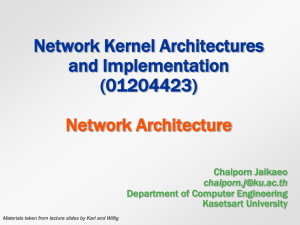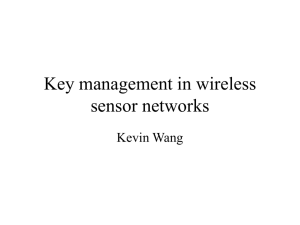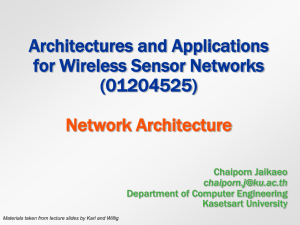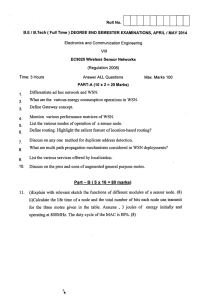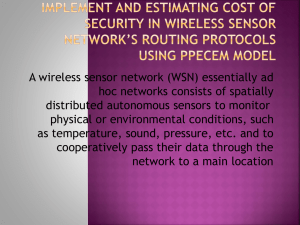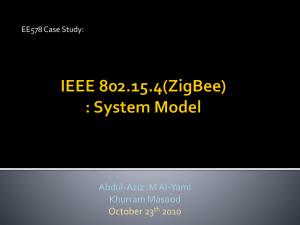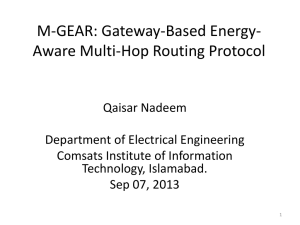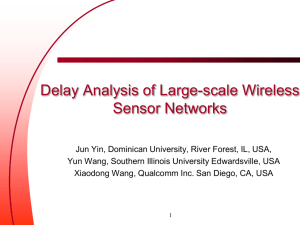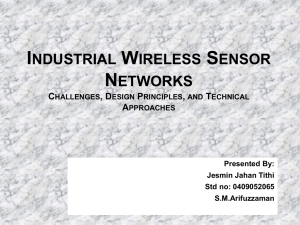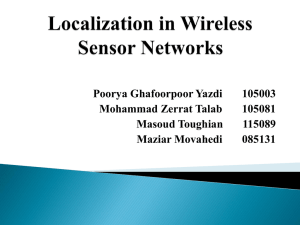Sensor networks
advertisement
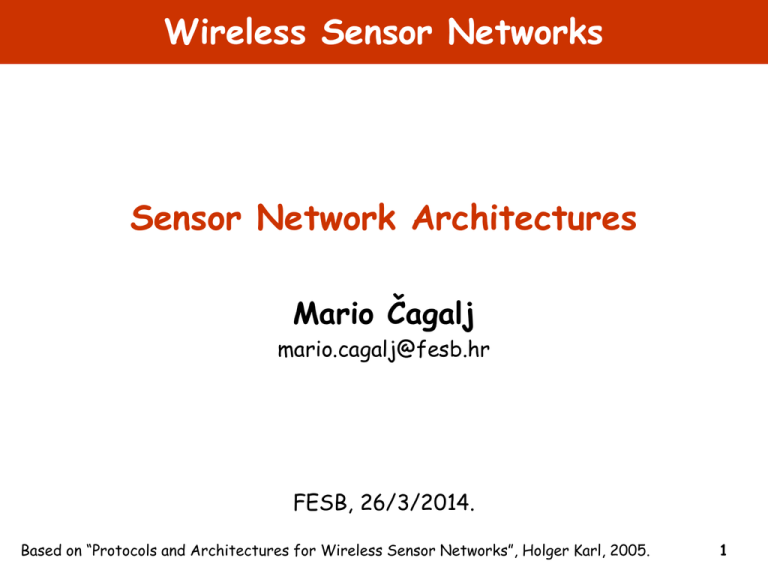
Wireless Sensor Networks Sensor Network Architectures Mario Čagalj mario.cagalj@fesb.hr FESB, 26/3/2014. Based on “Protocols and Architectures for Wireless Sensor Networks”, Holger Karl, 2005. 1 Goal of this lecture o Having looked at the individual nodes in the previous lecture, we look at general principles and architectures how to put these nodes together to form a meaningful network o We will look at design approaches to both the more conventional ad hoc networks and the non-standard WSNs 2 Basic scenarios: Ad hoc networks o (Mobile) ad hoc scenarios > Nodes talking to each other > Nodes talking to some node in another network (Web server on the Internet, e.g.) • Typically requires some connection to the fixed network > Applications: traditional data (http, ftp,…) and multimedia (voice, video) • Humans in the loop 3 Basic scenarios: Sensor networks o Sensor network scenarios > Sources: any entity that provides data/measurements > Sinks: nodes where information is required • Can belong to the sensor network as such • Can be an external entity, e.g., a smartphone, directly connected to the WSN – Main difference: comes and goes, often moves around, … • Can be a part of an external network (e.g., internet), connected to the WSN Source Sink Source Sink Source Sink WEB > Applications: limited amounts of data, different notions of importance 4 Single-hop vs. multi-hop networks o One common problem: limited range of wireless communication > Essentially due to limited transmission power, path loss, obstacles o Option: multi-hop networks > Send packets to an intermediate node > Intermediate node forwards packet to its destination > Store-and-forward multi-hop network o Basic technique applies to both WSN and MANET Source Sink Obstacle 5 Multiple sinks, multiple sources 6 Different sources of mobility o Node mobility > A node participating as source/sink (or destination) or a relay node might move around > Deliberately, self-propelled or by external force; targeted or at random o Sink mobility > In WSN, a sink that is not part of the WSN might move > Mobile requester o Event mobility > In WSN, event that is to be observed moves around (or extends, shrinks) > Different WSN nodes become “responsible” for surveillance of such an event 7 Sink mobility Request Propagation of answers Movement direction 8 Event mobility: Track the pink elephant 9 Optimization goals in sensor networks o Basic optimization goals include > Quality of Service (QoS) > Energy efficiency > Scalability 10 Optimization goals: Quality of Service o In traditional networks: Usual QoS interpretation > Throughput/delay/jitter > High perceived QoS for multimedia applications o In WSN, more complicated > Event detection/reporting probability > Event classification error, detection delay > Probability of missing a periodic report > Approximation accuracy (e.g, when WSN constructs a temperature map) > Tracking accuracy (e.g., difference between true and conjectured position of the pink elephant) o Related goal: robustness > Network should withstand failure of some nodes 11 Optimization goal: Energy efficiency o Umbrella term! o Energy per correctly received bit > Counting all the overheads, in intermediate nodes, etc. o Energy per reported (unique) event > After all, information is important, not payload bits! > Typical for WSN o Delay/energy tradeoffs o Network lifetime > > > > > Time to first node failure Network half-life (how long until 50% of the nodes died?) Time to partition Time to loss of coverage Time to failure of first event notification 12 Optimization goal: Scalability o Network should be operational regardless of the number of network nodes o Typical node numbers difficult to guess > MANETs: 10s to 100s > WSNs: 10s to 1000s, maybe more (although few people have seen such a network before…) o Requiring to scale to large node numbers has serious consequences for network architecture > Might not result in the most efficient solutions for small networks! > Carefully consider actual application needs before looking for n >> 1 solutions! 13 Design principles: in-network processing o Traditional networks are supposed to deliver bits from one end to the other o WSNs, on the other end, are expected to provide information, not necessarily original bits > Gives addition options > E.g., manipulate or process the data in the network o Main example: aggregation “along the path” > Typical functions: minimum, maximum, average, sum, … > This is however not possible with, for example, median 14 In-network processing: aggregation example o Goal: Reduce number of transmitted bits/packets by applying an aggregation function in the network 1 1 1 aggregate 1 3 1 1 1 aggregate 6 1 1 1 15 In-network processing: signal processing o Depending on application, more sophisticated processing of data can take place within the network > Example edge detection: locally exchange raw data with neighboring nodes, compute edges, only communicate edge description to far away data sinks > Example tracking/angle detection of signal source: Sensor nodes act jointly as a distributed microphone array, use it to compute the angle of a single source, only communicate this angle, not all the raw data o Exploit temporal and spatial correlation > Observed signals might vary only slowly in time -> no need to transmit all data at full rate all the time > Signals of neighboring nodes are often quite similar -> only try to transmit differences 16 Adaptive fidelity o Adapt the effort with which data is exchanged to the currently required accuracy/fidelity o Example event detection > When there is no event, rarely send short “all OK” messages > When event occurs, increase rate of message exchanges o Example: temperature measurement > When temperature is in acceptable range, only send temperature values at low resolution > When temperature becomes high, increase resolution and thus message length 17 Design principles: Data centric networking o In typical (traditional) networks, network transactions are addressed to the identities of specific nodes > A “node-centric” or “address-centric” networking paradigm o In a redundantly deployed sensor networks, specific source of an event, alarm, etc. might not be important > Redundancy: e.g., several nodes can observe the same area o Thus: focus networking transactions on the data directly instead of their senders and transmitters (data-centric networking) > Principal design change 18 Gateway concepts for WSNs o Gateways are necessary to the Internet for remote access to/from the WSN > Same is true for ad hoc networks; additional complications due to mobility (change route to the gateway; use different gateways) > WSN: Additionally bridge the gap between different interaction semantics (data vs. address-centric networking) in the gateway o Gateway needs support for different radios/protocols, … Gateway nodes Wireless Sensor Network Internet Remote users 19 WSN to Internet communication o Example: Deliver an alarm message to an Internet host o Issues > Need to find a gateway (integrates routing & service discovery) > Choose “best” gateway if several are available > How to find Alice or Alice’s IP? Alert Alice Alice‘s desktop Gateway nodes Internet 20 Internet to WSN communication o How to find the right WSN to answer a need? o How to translate from IP protocols to WSN protocols, semantics? > Example: 6LowPAN (IPv6 enabled sensor networks – rely on gateways) Remote requester Gateway nodes Internet Gateway node 21 WSN tunneling o Use the Internet to “tunnel” WSN packets between two remote WSNs > Eg., IPSec or OpenVPN based tunneling > Machine-2-Machine (M2M) type communication Internet Gateway nodes Gateway node 22 Example: Sensors to the Cloud http://www.libelium.com/products/plug-sense/wsn 23 Summary o Wireless Sensor Networks look quite different on many levels compared to traditional networks > Data-centric paradigm, the need and the possibility to manipulate data as it travels through the network opens new possibilities for protocol design (i.e., in-network processing) 24
